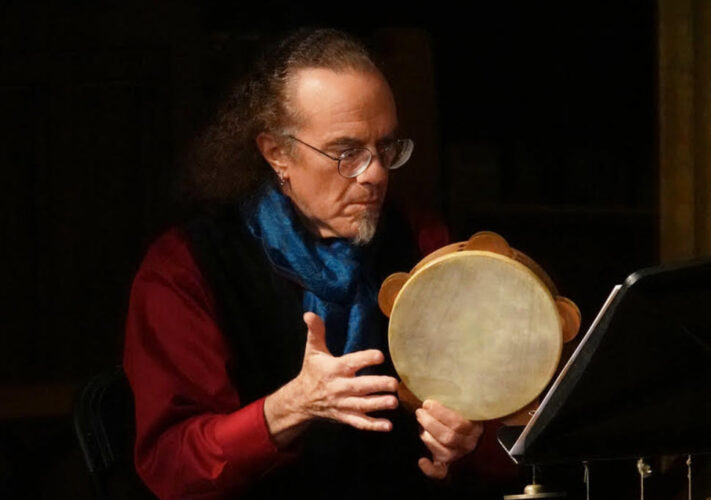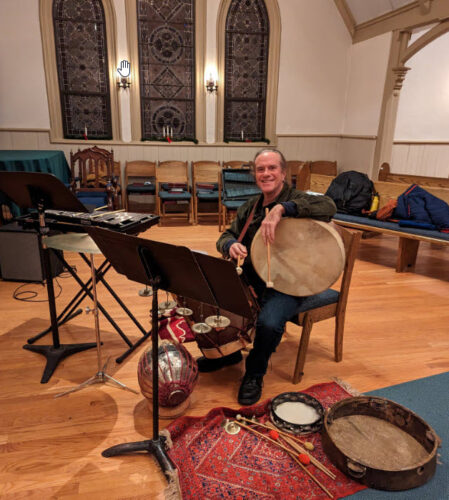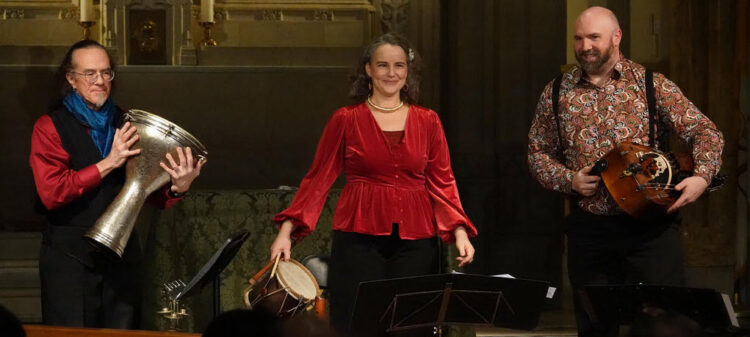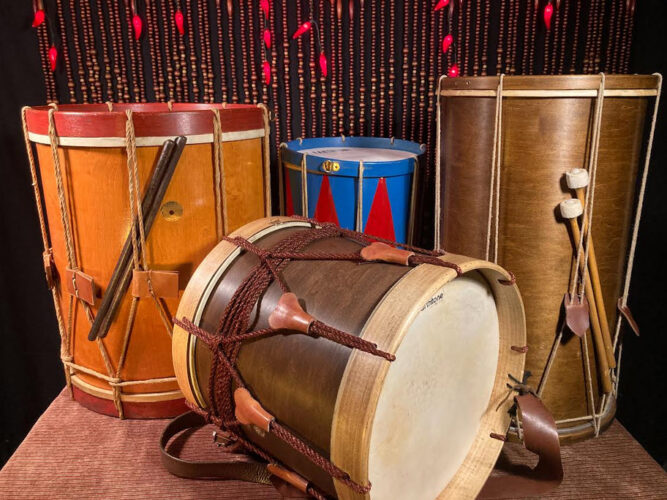An early-music percussionist walks us through his performance process and historically informed mindset. Much of what he plays was never written down.
A percussionist’s job is to add sounds and spices where the composer offers no guidance, from the European high Baroque to music of Mediterranean North Africa and the court of the Tang Dynasty.
This article was first published in the May 2025 issue of EMAg, the Magazine of Early Music America.

After a performance, audience members often approach the stage to talk. My percussion setup, with all of its various instruments, is like a magnet. “How many instruments do you have?” “What was that sound you were making with those things?” “What does your part look like?” I explain where each instrument comes from: Morocco, Spain, Italy, or the trash; the features of a specific frame drum; the reason I used it on this particular program, and so on.
After many years of performing music in various genres and picking up juicy tidbits of historical information along the way, I’ve developed a process for making decisions about which percussion instruments to use as well as what and when to play. In much of the music historical percussionists perform, there’s no part labeled “percussion” in the score.
In early-music settings, how does that work? Intuition, experience, and improvisation are key.

Let me tell you a bit about a project with the Sebastians in New York. Keyboardist and conductor Jeffrey Grossman invited me onto a program titled The 24 Violins, Jean-Baptiste Lully opera overtures featuring the full string sound plus continuo. I told him I prefer reading from full scores so I can see all that’s going on. From payroll sheets, we know that Lully, like many Baroque composers, employed percussionists in their opera orchestras. It was my job to image what they played.
With Lully’s printed music in front of me, I listened to various performances online and learned about the opera’s story and setting. I listened for the character and attitude of the music and figuring out what is being portrayed dramatically and musically. The opening Sebastians piece was Lully’s overture to Le triomphe de Bacchus dans les Indes, which is stately and processional. To me, this grand opening called for the sound of a side drum — much like the kind of drum depicted in Revolutionary War paintings with calf-skin heads and gut snares. I had this sort of drum, made by the Eames Drum Company in Saugus, Mass.
In the overture, the opening statement sounded royal, so this particular drum’s timbre was a perfect fit. The second section of the overture was different, trading back and forth between trio and the full ensemble, and which left plenty of room for not playing. I only came in to support phrases that answered the trio in a call-and-response style.
In other works, I found that a tambourine was helpful for the spritely sounding upbeat tunes and a sparse triangle for the delicate, languid pieces with a lot of long notes. Also, a frame drum (played with a mallet) and a tabor (without snares) added support for courtly dance pieces that were steady but not military in character.
Using a variety of instruments from piece to piece gives each work a different “shine” and helps to keep the audience, and me, entertained. I have a calfskin-headed rope tensioned tabor, for example, that is tunable to a certain degree, and mine has a range of about a fifth. I choose a pitch that makes harmonic sense for at least most of the passage, not just any random note.
‘If there is a lot of action in any of the voices, I stay out of their way‘
In general, if there is a lot of action in any of the instrumental voices, I stay out of their way, only playing supportive whole or half notes, or laying out altogether. If it’s in tune with itself, a tabor’s sound can take up a lot of sonic space and ring quite a bit in a mid to low register. Whether using a mallet, stick, or my fingers, I might dampen the drum a bit with my hand or a piece of cloth, playing phrases that outline and support the rhythms of the parts that I’m reading as guidelines. A percussionist doesn’t want to cover up the fancy stuff being played by the melodic voices.
With an ensemble as large as the Sebastians’ 24 Violins group, where everything on the program was meticulously composed, the challenge was to add parts that sounded perfectly natural — as if they’d always been there — but for some reason had never been included in previous performances.
Make it Sound ‘Fat’
Many of the early-music groups I play with are quartets or quintets, and their programs include various genres, from the Cantigas of Spain and Cypriot ballads to Armenian melodies, French and Italian art songs, and Moroccan, Tunisian, and Egyptian classical compositions.

ALBA Consort, specializing in Mediterranean and European early music, is one such group. Artistic Director Margo Andrea curates concerts where the music is generally written out — except the non-existent percussion parts! In those cases, I consider whether there’s even a need for my additions. It might be as simple as a lightly embellished frame drum part to keep an easy rhythmic “foot” pulse, which makes the four-person consort sound larger with more “bottom” during the instrumental sections. That’s a large part of my job: to make the band sound “fat” without getting in the way. Then, an instant later, I have to be ready to accommodate delicate lute parts or the next vocal entrance by perhaps playing fewer notes and dropping even more in dynamics. If I can’t hear the lute or the words I’m too loud.
On pieces that are of folk origin or only have a melody line as a starting point for recreating, the possibilities are endless. With folk songs from the wider Mediterranean, for example, I might use darbuka (aka dumbek or doumbeg) drums. These are the single-headed goblet-shaped drums that, thanks to millennia of trade and war, are found all over from the Middle East and North Africa to Iberia, the Italian peninsula, Sicily, and beyond. The original instruments were made any materials that were available, such as clay with goat- or fish-skin heads.
These days, it’s not easy to find those kinds of ceramic drums. Lots of companies, hoping to jump into the “world music” market, make modern versions of the dumbek with aluminum bodies and plastic heads. But I never use these for early music because their sound doesn’t match the texture and palette of my gut-stringed band mates.
So where do you get a traditional dumbek? Sometimes from a specialty shop; sometimes they come with a memorable story. I was once in Morocco performing concerts of Sephardic Music. The occasion was a reunion of Sephardim from all over the world. While in Marrakesh, we were treated to fantastic accommodations, meals, and bus tours to outlying towns where people reconnected with their families’ histories. One great outing was to a kasbah in the middle of the desert, with folkloric music and dance groups, mostly performed by Berbers from the Atlas Mountains.
At the end of the evening, after watching drummers periodically heat their bendir frame drums over a large fire, I was hanging around, trying to get a good look. This particular drum had eight sets of hand-hammered brass jingles like a giant tambourine. I later found out that the Berbers call it an alloun. After some negotiation, I wound up buying the drum for 300 dirham (about $30). I couldn’t believe that I was going to own this unique piece of craftsmanship. Then I spent the next 4 days sniffing it because it smelled like wood smoke and goat! It’s one of the most real instruments I own and sounds like no other.
To tune that alloun drum on soggy days — building a fire onstage is frowned upon nowadays — I carry a couple of heating pads. They help make skin-headed drums sound perkier. I also carry some decorative stage mats on which to safely rest all of my instruments and to avoid clunking things down on a hard surface when I exchange instruments in the middle of a piece.

By layering your sounds, a single percussionist can sound like an entire percussion section. You have four limbs and can keep busy by bringing sounds in and out, always playing in phrases. Pilgrimage songs that were meant to celebrate a journey, or story-songs meant to pass the time and miles, are the perfect occasion for a group improvisation. It’s a major part of this musical tradition: They didn’t just play the melody once and go on to some other song. An easy-to-carry frame drum, some small cluster of bells for refrains, plus muffled clapping or the light chinking sound of a jostled bag of coins — along with the light thump of a walking stick to help keep a steady walking pace — are solid guesses of what people did while walking for days. From a percussionist’s point of view, it’s a wide field of possibilities. As long as you’re adding something useful to the music and not covering up the text, these parts and sounds add grounding, texture, variety, and depth while helping to set the scene.
Drumming in Latin America
Since at least the early 1950s, there has been renewed interest in the Baroque-era music found in Catholic Church archival collections in Central and South America, written by composers in the New World mainly for liturgical use but also for public consumption. Music was successfully employed as a missionary technique, complete with all the fantastically ornate styles of the Spanish Baroque style using singers, harps, guitars, trumpets, chirimias, vihuelas, and organ. These “new” percussion instruments of the time included indigenous wood rattles, goat hooves, South American-style tabors (sometimes called bomb criollo), the cajon, maracas and guiros. When we perform these pieces today, all of these sounds are possibilities.
I’ve been fortunate to perform Spanish Baroque music and its Central and South American extension with a number of large as well as small ensembles: Apollo’s Fire, Ensemble Caprice, Bach Collegium San Diego, and the Bishop’s Band, to name a few. Some of this repertoire is heavy on large choral and solo vocals, where five or six parts overlap and fly in and out with next-to-impossible rhythmic complexity. What can a percussionist do to be helpful? Sometimes I just play with one part for a couple of phrases and then move on to support a different vocal part after they enter. Why do I wait until after they enter? Because I don’t want to obscure the opening statement of their composed part. I slide in underneath them for a while, helping to make the rhythmic phrases and hemiolas clear, and then move on to the next vocal entrance. This is why my percussion playing (on tabor, castanets, or cajon) sounds improvised and composed at the same time.
‘My percussion playing sounds improvised and composed at the same time’
And every once in a while, for variety’s sake, I might establish a pairing of a specific vocal part with an instrument, chosen to stay out of their range. For example, using a wood block sound with the baritones or using the tabor and goat hooves with the tenors.
When I played a program of Baroque Music of Spain and Latin America with the Concordia Chamber Players, their artistic director, Michelle Djokic, trusted me to do whatever I thought would work. On a number of pieces, I wrote at the top of my page the words “Listen and Play.” I locked into the phrasing of the lute or guitar (Daniel Swenberg) and the breathing of the soprano (Nell Snaidas) so I could match her consonants and rubato phrasing. I watched the body language of the cellist and the bows of the viola and violinist (Siwoo Kim and Francisco Fullana). It was as if I was playing within a school of fish or a murmuration of starlings.
My most versatile instrument when playing in early-music settings is often a good-quality frame drum. It can be the perfect instrument to accompany sensitive, swooping, spacious soundscapes, instrumental or vocal. Whether using a mallet or my fingers, a frame drum can sound lush, delicate, or sharp. And while I breathed together with that Concordia combination of musicians, those dynamic and textural possibilities were exactly what I was looking for.
Frame drums have been around for a very long time and in almost every region on earth. And for good reason: They don’t take a lot of resources to make or require large pieces of wood, just a thin wood frame and a skin of some sort. They’re light in weight and easy to travel with. They were an easy portable drum choice for travelers on stages of the Silk Road, connecting China to the Levant. Essentially the drums haven’t changed much. Goat skin was, and still is, used because the animal is common and their skin is thin and easy to mount on a frame. Other natural skin-drum heads might be calf, elk for your North American drum maker, or fish — especially skate fish found in the Nile.
‘It was as if I was playing within a school of fish or a murmuration of starlings’
Those skate fish-heads are still used on Egyptian-style tambourines called a riqq. Riqqs, frame drums, and so many others made their way from East to West all across North Africa to Morocco and up into Andalusia. I once had a fish skin on a riqq but it couldn’t survive the dry heat of my New York apartment in winter. So I had the original maker, Abdul Hamid Alwan, living in Milwaukee, re-head it for me with much more durable calf.
Rediscovering the Hokyo
A little farther off the familiar path of European early music, I have been playing and recording with a group that has presented court music of the Tang Dynasty. Eurasia Consort, with artistic co-directors Tomoko Sugawara (harps) and August Denhard (five-string biwa lute), has been performing music found in the Dunhuang Caves in China’s Gansu Province. This collection of early pipa pieces — transcribed by scholars from Shanghai Conservatory into modern notation — combined with illustrations of the court music ensembles, has been an interesting path for me to explore.

With Eurasia Consort, I play large and small Chinese yak-headed drums and cymbals, inventing my parts with Sugawara’s input. Many are ceremonial processional pieces; some are lighthearted drunken dance tunes. An instrument that has really captured my attention is called the hokyo, which is essentially a double-rowed vertical glockenspiel. It’s not laid out like a western glock with “white keys” and “black keys.” It’s somewhat chromatic but has several notes missing from each row. Most of the notes I play on the hokyo are written out for me to read. I’m free to add tasteful ornaments of my choice and I do play some improvised melodic introductions. When I first started playing the hokyo, I had to concentrate more than I would have expected.
The hokyo went out of fashion after the Tang period (618 – 907). The lone surviving partial specimen is found in the Shōsōin Repository in Nara, Japan. The Dunhuang Cave wall murals depict it in various court music ensemble settings. With this background, Eurasia Consort commissioned historical instrument maker Bill Campbell to build one of these metallophones for the group.
Remember that a lot, if not most, early music (with the exception of composed Baroque timpani parts on some larger scale works) has not been written for or performed with percussion.
Remember that with the exception of some larger-scale Baroque works scored with timpani, most early music had not been composed with percussion parts. But if you are that player, there is a responsibility to contribute sounds, rhythms, and parts that are well conceived and helpful. Don’t play absentmindedly just to fill sonic space. Play in phrases, like a singer, and not robotically like a machine. The percussion palette is powerful; it should support, brighten, and enhance the ensemble all the while being careful to not obscure intricate melismatic passages. Every note counts. A percussionist’s sound draws attention, and maybe lots of questions after the show. So remember the fundamentals: “less is more” and “do no harm!”
Rex Benincasa is an early-music specialist, world-music percussionist, and freelance drummer. He has performed on Broadway, for TV and radio broadcasts, and on projects and concerts ranging from Apollo’s Fire and the Philip Glass Ensemble to Sesame Street, the Merce Cunningham Dance Company, and NFL Films.

